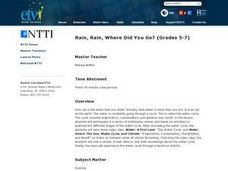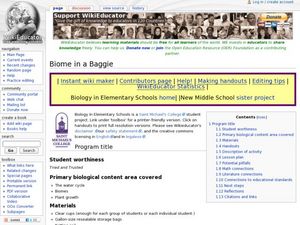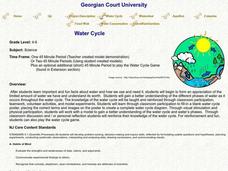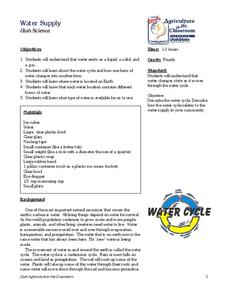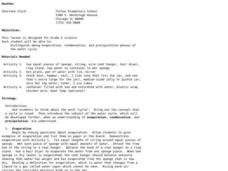Curated OER
How Trees Contribute to the Water Cycle
In this water cycle instructional activity, 3rd graders conduct an experiment where they observe and calculate how water transpires in different types of trees. Students engage in a class discussion and use Venn Diagrams to compare...
Curated OER
Rain, Rain, Where Did You Go?
Students study the water cycle including condensation, evaporation, and precipitation. In this water cycle lesson plan, students watch a video and access assigned web sites to investigate the water cycle. They complete an experiment with...
Curated OER
The Water Cycle in a Bowl
Students conduct an experiment on the stages of the Water Cycle. In this water cycle lesson, students view the materials needed for the experiment and brainstorm how they relate to the Water Cycle. Students conduct an...
Curated OER
Biomes and the water cycle
Students create a desert biome and a prairie biome and see how plants survive in both. In this biomes lesson plan, studnets create their biomes and see how the water cycle effect each biome and plant differently.
Curated OER
Clouds
Students explore clouds. In this weather lesson, students identify the steps in the water cycle, define condensation and evaporation, and relate this information to cloud formation. Students perform a cloud experiment,...
Curated OER
Local Hydrologic Cycle
Students draw the water cycle as it occurs in their community. In this water cycle lesson, students observe demonstrations of sublimation and infiltration. They also use photographs or their own drawings of their...
Curated OER
Hydrologic Cycle Scavenger Hunt
Students explore the water cycle using educational resources. In this water cycle lesson, students use a global climate DVD to complete a scavenger hunt on the hydrologic (water) cycle.
Curated OER
Water Cycle Bag
Learners enclose water in an airtight bag and leave it in a warm area to view the water cycle. In this water cycle lesson plan, students observe evaporation, condensation, and precipitation. They then discuss what they learned about the...
Curated OER
Water: The Incredible Resource
Students understand the importance of water in any ecosystem. In this water lesson, students recognize where water is found, the type of water found, and how water is changed in the water cycle. Students complete worksheets using...
Curated OER
Thirsty Rocks: Please "Porous" a Drink!
Discover what it means when a stone is porous or permeable. For this geology lesson, investigate a sandstone and complete a lab exercise which displays how porous and permeable a stone can actually be then measure these terms as well.
Curated OER
The Cool Forms of Water
Young scholars discover the different forms of water on Earth. In this states of water lesson, students read material on the different forms of water and how they are created. The young scholars answer written questions on worksheets.
Curated OER
Rain On
Fourth graders study the water cycle and clouds. In this water cycle and cloud lesson, 4th graders determine the definition of condensation and watch a demonstration in which the teacher makes a cloud in a bottle. They discuss the water...
Curated OER
Ecology Study Guide
In this ecology study guide, students fill in a table about producers, consumers and decomposers, they draw the water cycle, they fill in diagrams about cell respiration, the food pyramid, protein synthesis and nitrification, population...
Curated OER
Water Cycle
Students explore the water cycle. In this water cycle lesson, students examine water as a resource as they create a water cycle poster and create a water cycle model. Water cycle game instructions are included as well.
Curated OER
Water Cycle Voice Thread
Students understand the water cycle through a role playing activity. In this water cycle lesson, students become familiar with the water cycle through a play about the water cycle. Students illustrate their parts and create a VoiceThread...
Curated OER
Make It Rain!
Students complete an experiment. In this precipitation lesson plan, students complete an activity where they make rain in a jar.
Curated OER
Water Supply
Fourth graders complete three activities. In this water supply lesson, 4th graders learn that water can exist in different forms and watch a demonstration of each form. Students explore the water cycle and make a water cycle using the...
Curated OER
Round and Round-The Water Cycle
Students explore the water cycle. In this earth science activity, students work in small groups to read various books on the water cycle and take notes on chart paper. Students share their notes and teach a younger audience what they...
Curated OER
What Goes Around Comes Around
Students investigate how the ocean plays a part in the water cycle. In this earth science activity, students locate a puddle outside and mark it with chalk. Students observe the changes in the water during the next two days.
Curated OER
Is the Hudson River Too Salty to Drink?
Students explore reasons for varied salinity in bodies of water. In this geographical inquiry lesson plan, students use a variety of visual and written information including maps, data tables, and graphs, to form a hypothesis as to why...
Curated OER
The Water Cycle Story
In this recognizing the vocabulary for the water cycle worksheet, students use the words in the word bank to fill in the blanks and complete the sentences. Students write 8 answers.
Curated OER
Air and Water in the Environment
Students explore the traits of water condensation and evaporation. In this water cycle lesson, students develop an awareness of the importance of water for sustaining life. Students participate in a hands-on activity in which water is...
Curated OER
Weather
Fifth graders study the water cycle. In this science lesson plan, 5th graders distinguish among evaporation, condensation, and precipitation phases of the water cycle.
Curated OER
The Magic School Bus Wet All Over
Young scholars observe the water cycle and experiment with cleaning water. In this hands-on hydrology lesson based on a Magic School Bus book, students conduct two experiments to see the how water moves through the water cycle and then...

